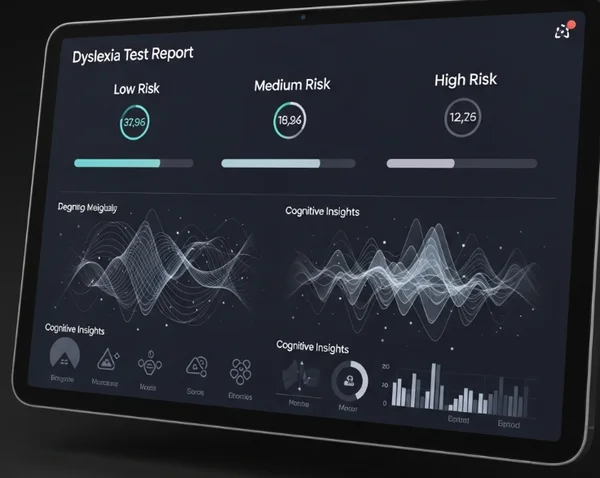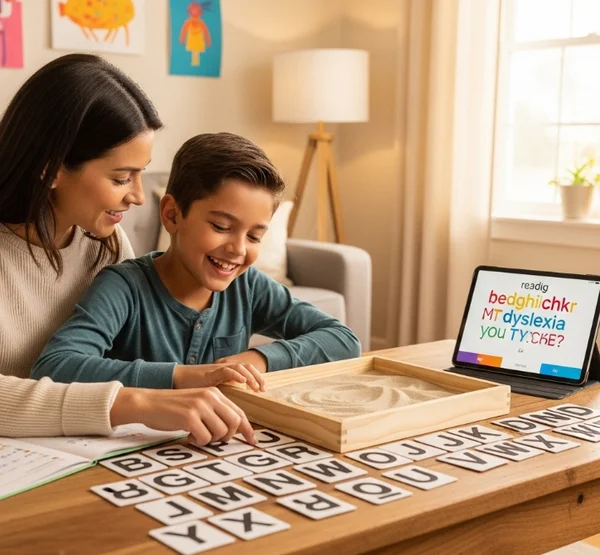Interpreting Your DyslexiaTest.online Report & Next Steps
It's perfectly natural to feel a mix of emotions when you receive a dyslexia test report. You might feel relief at having some initial answers, but also a sense of uncertainty about what comes next. What does your dyslexia test report really mean? Here, we'll demystify your results from our online assessment, helping you understand your risk score and cognitive insights. More importantly, it will empower you with clear, actionable next steps for your child or even for yourself, putting you on the path to unlocking reading potential. If you haven't taken the test yet, you can take our online dyslexia test now today.
Understanding Your Dyslexia Test Report & Risk Score
After completing our comprehensive 12-question online assessment, you receive an instant report. This report is designed to provide a preliminary dyslexia screening, offering valuable insights into potential reading challenges. Knowing how to interpret these initial findings is crucial.
What Does Your Dyslexia Risk Score Mean?
Your report will feature a dyslexia risk score, categorizing the likelihood of dyslexia into low, medium, or high risk.
- Low Risk: This indicates that the patterns observed in the screening questions do not strongly suggest the presence of dyslexia. While this is reassuring, remember that this is a screening tool. If you still have concerns, ongoing observation and discussion with educators are always recommended.
- Medium Risk: A medium risk score suggests that there are several indicators present that warrant further attention. This is a common outcome that highlights the need for closer observation and consideration of additional steps, such as engaging with your child's teacher or exploring more support strategies.
- High Risk: A high risk score means that the responses strongly align with common signs of dyslexia. This result is a clear signal to pursue further investigation and typically prompts the recommendation for a professional assessment. It's a significant indicator that specialized support might be beneficial.
Understanding this score is the first step in interpreting dyslexia results and formulating a plan.

Decoding Your Cognitive Insights and Strengths
Beyond a simple risk score, your report offers deeper cognitive insights. The test evaluates key areas like phonological awareness, decoding, reading fluency, comprehension, and spelling. These insights highlight not just areas of potential difficulty, but also cognitive strengths. For instance, a child might show challenges in phonological processing but possess strong comprehension skills when listening. This nuanced understanding is invaluable. It helps parents and educators identify specific areas where targeted support is most needed, while also recognizing and building upon existing strengths. This personalized view can significantly shape the approach to learning and support.
Online Screening vs. Formal Diagnosis: The Key Difference
It's important to remember a core principle: our online dyslexia screening tool provides an online dyslexia test for screening, not a formal clinical diagnosis. A screening tool is designed to identify individuals who may be at risk for a particular condition, prompting further evaluation. Think of it as a helpful flashlight, illuminating areas that might need closer inspection. A formal diagnosis, on the other hand, is a comprehensive process conducted by qualified professionals, such as an educational psychologist or a specialized learning disabilities specialist. This process involves a battery of tests and assessments to definitively determine if dyslexia is present. Our commitment to clearly stating this distinction builds trust and ensures you take the appropriate next steps for understanding.

Actionable Next Steps After Your Dyslexia Online Test
So, you've reviewed your dyslexia test report, and you have a clearer picture. Now comes the crucial part: what to do after a dyslexia test? The journey to unlocking reading potential is a collaborative one, and our platform aims to guide you through it.
Communicating Effectively with Your Child's School or Teacher
If your child's report indicates a medium or high risk, or if you've simply had ongoing concerns, communicating with their school or teacher is an essential next step. They spend significant time with your child and can offer valuable observations.
- Prepare: Bring your report to the meeting. It provides concrete, data-driven insights to start the conversation.
- Share Observations: Explain the specific signs of dyslexia you’ve observed at home and how they impact your child’s learning.
- Collaborate: Discuss the school's existing support systems. Ask about classroom accommodations, reading intervention programs, or in-school dyslexia screening options. Many schools have resources available to help students with learning differences.
- Document: Keep a record of your conversations, observations, and any strategies agreed upon.
This proactive communication can pave the way for early support and understanding within the educational environment.

When and How to Seek a Professional Dyslexia Assessment
While our free dyslexia test provides an excellent starting point, a professional assessment is the gold standard for diagnosis.
- When to Seek: If your child's risk score is medium or high, or if school interventions don't yield significant progress, it's time to consider a professional evaluation. Adults who suspect they are dyslexic can also seek assessments.
- Who to Contact: Look for educational psychologists, neuropsychologists, or specialists in learning disabilities. They conduct comprehensive assessments that delve into various cognitive and academic skills.
- What to Expect: A formal assessment involves multiple sessions and tests designed to evaluate reading, writing, spelling, and underlying cognitive processes. This detailed evaluation provides a definitive diagnosis and often comes with tailored recommendations for support.
- Cost: What is the cost of a formal dyslexia assessment? This can vary widely depending on location and the professional's fees, ranging from several hundred to a few thousand dollars. Many insurance plans do not cover educational assessments, so it's important to inquire beforehand.
Understanding how to test for dyslexia professionally is a crucial part of this journey.
Empowering Strategies to Support Reading at Home
Regardless of the next formal steps, there are many empowering strategies you can implement at home to support reading development.
-
Read Aloud Together: Continue reading to your child, even as they get older. This builds vocabulary, comprehension, and a love for stories.
-
Focus on Phonological Awareness: Engage in fun activities that develop sound awareness, like rhyming games, clapping out syllables, or identifying initial sounds in words.
-
Multi-Sensory Approaches: Incorporate touch, movement, and sight into learning. Use sand trays for letter formation, finger-trace words, or use tactile letters.
-
Break It Down: Divide reading tasks into smaller, manageable chunks. Celebrate small victories to build confidence.
-
Utilize Technology: Explore assistive technology like text-to-speech software, specialized fonts, or reading apps designed for individuals with dyslexia. These tools can significantly ease the reading process.
-
Patience and Encouragement: Remember that learning differences require patience. Celebrate effort and progress, fostering a positive attitude towards reading. For more comprehensive ideas, explore our blog for articles on how to help a child with dyslexia through daily activities.

Exploring the DyslexiaTest.online AI Personalized Report
For those seeking even deeper insights, our platform offers an optional, AI personalized report. After your initial screening, you can answer additional questions that allow our advanced AI to generate a more detailed analysis. This report provides enhanced cognitive insights and highly individualized recommendations tailored specifically to your unique profile. It's a powerful tool for gaining a more nuanced understanding and planning targeted support. Consider exploring this feature to get your AI report and further refine your path forward.
Empowering Your Journey: Next Steps to Unlock Potential
Understanding your dyslexia test report is not the end, but a vital beginning. It’s the first informed step on a journey toward understanding reading challenges and unlocking the full potential within yourself or your child. Our platform is committed to being a trusted resource throughout this process, offering not just a free screening tool, but also a wealth of educational resources and actionable advice.
We encourage you to explore our blog for more articles on decoding dyslexia, effective support strategies, and related learning differences. Every piece of knowledge gained empowers you to advocate effectively and provide the right support. Don't let a potential diagnosis be daunting; let it be a guide. Take control of your or your child's learning journey by understanding the results and taking the next steps for success.
Frequently Asked Questions About Dyslexia Test Results
Is an online dyslexia test accurate for diagnosis?
No, an online dyslexia test like the one on our platform is a screening tool, not a diagnostic one. It helps identify potential signs and dyslexia risk score levels that suggest further evaluation might be needed. A formal diagnosis requires a comprehensive assessment by a qualified professional, such as an educational psychologist or learning specialist.
What is the cost of a formal dyslexia assessment?
The cost of a formal dyslexia assessment can vary significantly based on location, the professional conducting the assessment, and the depth of testing required. It typically ranges from several hundred to a few thousand dollars. It's advisable to check with local resources or insurance providers, as educational assessments are often not covered by health insurance.
How can I help my child with dyslexia at home based on this report?
Your dyslexia test report provides initial cognitive insights that can guide home support. Focus on multi-sensory activities, reading aloud together, practicing phonological awareness games, and celebrating small achievements. The website's blog offers various practical support strategies and resources on how to help a child with dyslexia at home.
Can schools test for dyslexia, or do I need a private assessment?
Can schools test for dyslexia? Many schools conduct initial screenings for reading difficulties and provide interventions. Some schools may have access to professionals who can conduct more in-depth assessments as part of special education services. However, the scope and availability vary. If a school assessment isn't comprehensive enough, or if you prefer a private evaluation, seeking an independent professional assessment is an option. For the first step, consider our free dyslexia test to gather initial insights before discussing with the school.